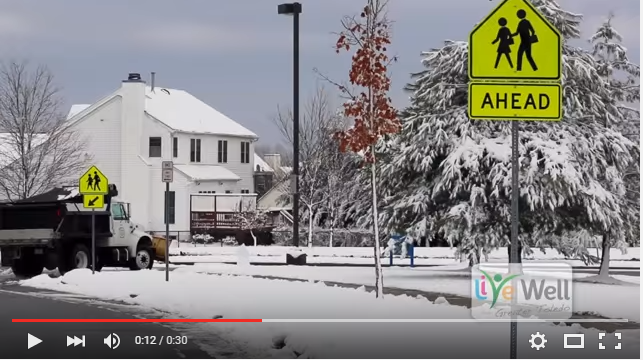Snow has been in the news lately, and communities, Safe Routes to School Programs, and walking advocates are stepping up and sharing solutions and tips for students and residents to walk safely in the snow. Personal preparation and community education and engagement are the best solutions to walking during the winter months.
Snow Angels Project, Toledo, Ohio: A Public Education Initiative
Toledo, Ohio recently unveiled an education and awareness program Called Snow Angels, a volunteer program that recruits community groups and interested people to assist schools with snow removal on sidewalks on priority walking corridors, as identified by the Toledo Safe Routes to School program. The purpose of Snow Angels is to make sure there are safe, cleared walking routes by assisting community members who may need snow removal help (elderly, people with disabilities) and conducting snow removal at vacant properties (as identified by the city) along Safe Routes to School priority corridors.
"The Toledo Snow Angels initiative helps keep Toledo walkable and addresses the identified barrier of snow removal in the Toledo school travel plan that impedes safe active transportation for students during winter months,” explained Jenny Hansen, Toledo’s Safe Routes to School coordinator.
Door hangers were also developed to promote both the program and residents' sense of civic responsibility. They will be distributed by law enforcement, zoning and building inspectors, and volunteers who are shoveling walks along school priority walking corridors that are not in compliance. A snow removal video PSA and radio spot were also created and are being run on their community channels and YouTube. “Educating community members on their responsibility to clear their walk ways of snow and ice within 24 hours of a snowfall, and encouraging them to help those in their neighborhood that are elderly or have mobility issues is a city wide solution to this barrier, while building a sense of community within school neighborhoods," says Hansen.
Toledo hopes to someday have all 40 of their schools adopted by Snow Angel organizations, so all school priority corridors are receiving attention after snow events.
|
Cold Weather Walking Safety Tips Sourced from the Safe Routes Partnership listserve by Charles Bingham of Alaska (and he should know!): Wear layers. You might feel cold when you start out walking or biking, but you'll warm up as your blood gets flowing. Make sure you wear a hat (you lose a lot of heat through the top of your head) and gloves or mittens (mittens are better for when it's really cold, and you can wear gloves inside your mittens for when you have to do some work that requires dexterity). If it's really cold, a scarf or balaclava/face mask will help prevent frostbite of the face. Wear good, sturdy shoes, preferably with rubber soles (not the plastic compound soles found in most athletic shoes). Boots are good for when it's snowy or rainy, and make sure they are a touch big so you can add wool socks or have the air around your toes be warmer than in tight boots. When it is icy, ice cleats can greatly improve traction. Since it tends to be dark much of the day in winter, wear bright, reflective clothes to make you more visible to drivers (who tend to not defrost their windshields or drive while texting). Common door prizes or giveaways for Safe Routes To School programs here include reflective tape for jackets and bike frames (get the sides, not just the back and front). Remind the kids to stay hydrated, since the cold dehydrates you. Remember to drink water, not eat snow (eating too much snow can cause problems with maintaining body temperature). |
Additional Programs and Resources
The Big Dig, Akron, Ohio: In 2014, Akron’s Safe Routes to School team investigated policy and other avenues to address snow removal in residential neighborhoods that affect the 90 percent of students with no school transportation. Walking in the street or on icy sidewalks has contributed to student injuries and lower school attendance. The Big Dig is their first initiative to address residential snow removal issues- a public education and safety program where K-8 students will get together “to shovel snow around schools, targeting areas that need special attention.”
Additional Resources: (Thanks, Maren Hill of Vermont Safe Routes to School!)
- The Canadian Safe Routes to School page has a number of tips for winter walking: http://www.saferoutestoschool.ca/winter-walk-day-ideas
- Go DC Go has an infographic (bet it is getting a lot of attention lately!): http://www.godcgo.com/Portals/0/Content%20Images/WalkWinterGuide_web.pdf.
- Vermont Safe Routes to School has a brief tip sheet: http://saferoutes.vermont.gov/sites/saferoutes/files/Guide_Winter%20Walking%20%282%29.pdf
- The National Center for Safe Routes to School: “Making Cold Cool: Keeping your SRTS Program going during Winter” Webinar: http://www.saferoutesinfo.org/training/srts-webinars/making-cold-cool-keeping-your-srts-program-going-during-winter


